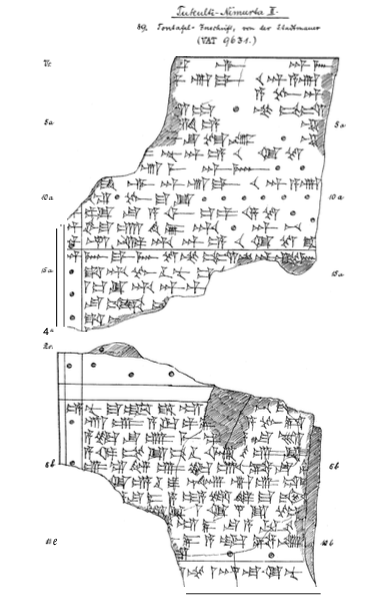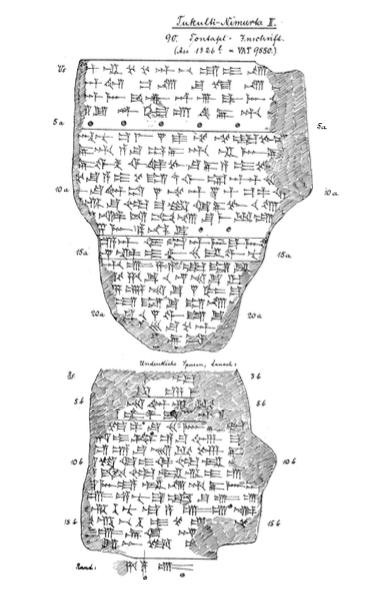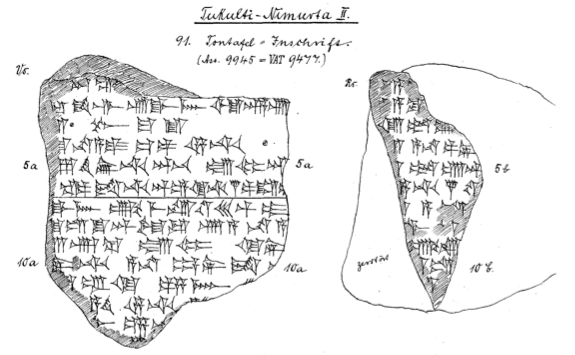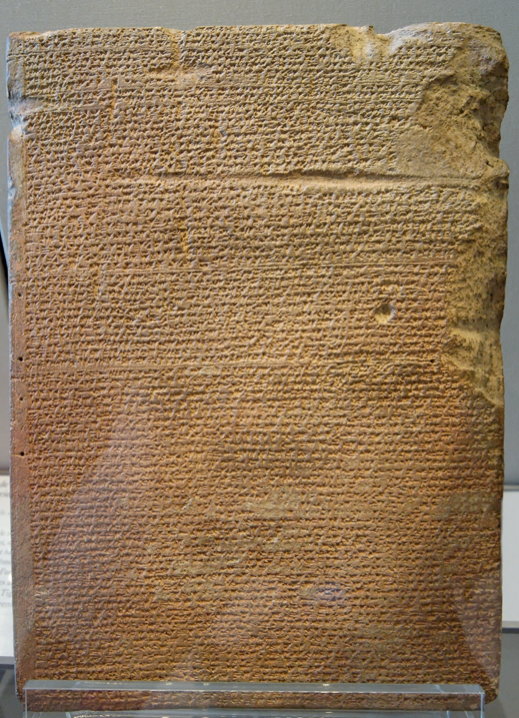Texts nos. 1-17
Browse the RIAo Corpus [http://oracc.museum.upenn.edu/riao/pager/]
1 2 3 4 5 6 7 8 9 10 11 12 13 14 15 16 17
1
In previous editions (e.g., RIMA 2), Tukulti-Ninurta II text no. 1 was in fact not a text, but a standard introduction common to texts nos. 2-4, following a similar approach used for the inscriptions of Adad-nārārī I. Here text no. 1 has been deleted. For its contents, now see Tukulti-Ninurta II 02 obv. 1–19, Tukulti-Ninurta II 03 obv. 1–23, and Tukulti-Ninurta II 04 obv 1 '–14 '.
Bibliography
2

KAH 2 no. 89
A fragmentary clay tablet from Ashur bears a text dated to the king's frist year of teign, recording the works carried by Tukultī-Ninurta II probably in the oldest quarter of the city, Baltil.
Access the composite text [http://oracc.museum.upenn.edu/riao/Q006032/] of Tukultī-Ninurta II 02.
Bibliography
3

KAH 2 no. 90
A text from a clay tablet fragment from Ashur, bears an inscription that records, after the introductory part, the works on the palace terrace at Ashur. The text has been recontructed by Grayson on teh basis of its similarity with text no. 5.
Access the composite text [http://oracc.museum.upenn.edu/riao/Q006033/] of Tukultī-Ninurta II 03.
Forthcoming
Bibliography
4

KAH 2 no. 91
A clay tablet fragment from Ashur bears a text, which probably records the works carried by Tukultī-Ninurta II on some structure at Ashur. While teh obverse is fairly legible, the reverse is almost completely destroyed.
Access the composite text [http://oracc.museum.upenn.edu/riao/Q006034/] of Tukultī-Ninurta II 04.
Bibliography
5

AO4655 (source: Wikipedia)
This text represent the most extensive version of the annals of
Tukultī-Ninurta II, and it is inscribed on alarge clay tablet coming
from Ashur, which was probably the second tablet (as it begins in
media res with a description of the ruler's second year of reign) of a series on which
the annals would have been recorded. The campaigns narrated therein
took place in the lands of Nairi (lines 1-29) and Mount Ḫabruru (lines
30-40), along the Wadi Tharthar to Dūr-Kurigalzu and Sippar in
Babylonia (lines 41-27), and then upe the Euphrates past Anat to the
Ḫabur, before crossing the Jazirah towards Ḫuzirina on the Baliḫ and
going back to Ashur. The narrative follows an itinerary-pattern, rather monotonous and full
of repetition of the same phrases ("Moving on from A I approached B. I
pitched camp and spent the night in B. Moving on from B...")
The building section of the text (lines 136-141) records the
construction of the wall of the palace terrace at Ashur, already rebuilt by Aššur-bēl-kala [http://oracc.museum.upenn.edu/riao/thekingdomofassyria1114884bc/ashurbelkala/index.html]
(1073-1056 BC), and it is probably the same "large terrace of
the New Palace" described in the Broken Obelisk (Aššur-bēl-kala, text
no. 7 v 20-31 [/riao/Q005988.138/]).
Access the composite text [http://oracc.museum.upenn.edu/riao/Q006035/] of Tukultī-Ninurta II 05.
Bibliography
6
A stone slab found at Nineveh was originally meant for Nēmed-Tukultī-Ninurta, a city that is otherwise unknown, and it is inscribed with a text describing the geographical extent of the king's conquests. The inscription was never sent to the destined city, and it would have been later re-used in the palace of Ashurnasirpal II at Nineveh.
Access the composite text [http://oracc.museum.upenn.edu/riao/Q006036/] of Tukultī-Ninurta II 06.
Bibliography
7
A fragment of a yellow glazed clay plate is inscribed with an inscription of Tukultī-Ninurta II, possibly recording the works on the towers at the door of the Enpi temple in the temple of Aššur at Ashur.
Access the composite text [http://oracc.museum.upenn.edu/riao/Q006037/] of Tukultī-Ninurta II 07.
Bibliography
8
A stone amulet from the Louvre is said to have had an inscription by Tukultī-Ninurta II dedicating the gem to the sun-god Shamash. The object, however, has no known museum number and has not been located, yet.
Access the composite text [http://oracc.museum.upenn.edu/riao/Q006038/] of Tukultī-Ninurta II 08.
Bibliography
9
This brief text is inscribed on two stone slabs, currently housed in the Aleppo museum. One slab survives only as a fragment, while the other is fully preserved. The latter measures 100 × 82 cm, which was presumably the original size of its broken counterpart. Both objects were found at Tell Barri, which allows us to identify that city with the ancient city of Kaḫat, as this is the name given to the location in the text.
Access the composite text [http://oracc.museum.upenn.edu/riao/Q006039/] of Tukultī-Ninurta II 09.
Bibliography
10
This text is engraved on a stone weight in the shape of a duck. The exact weight of the object is unknown but its height is 5.4 cm and its length is 9.8 cm. The inscription itself gives the object's weight as two-thirds of a mina. The weight is reported to be porphyry. The provenance of the object is unknown. It is currently kept in a private collection.
Access the composite text [http://oracc.museum.upenn.edu/riao/Q006040/] of Tukultī-Ninurta II 10.
Bibliography
11
This label is engraved on an agate bead of 2 × 2.5 × 1.4 cm. As we are told in the inscription, it was part of a necklace worn by Tukultī-Ninurta II. It is bored lengthwise for the purpose and is white in colour, with flecks of orange. It was found at Khorsabad (Dūr-Šarrukīn) and is currently housed in the Louvre.
Access the composite text [http://oracc.museum.upenn.edu/riao/Q006041/] of Tukultī-Ninurta II 11.
Bibliography
12
The titulary of this fragmentary text, found on a piece of clay cone at Nineveh, can be restored from the titulary of Ashurnasirpal II [http://oracc.museum.upenn.edu/riao/theassyrianempire883745bc/ashurnasirpalii/index.html] (see, for example, text no. 39 [http://oracc.museum.upenn.edu/riao/Q004493/]). Note that while it appears to be similar to text no. 13 [http://oracc.museum.upenn.edu/riao/Q006043/], that text omits the phrase "great king" (šarru rabû) and therefore they are to be classed as different texts.
Access the composite text [http://oracc.museum.upenn.edu/riao/Q006042/] of Tukultī-Ninurta II 12.
Bibliography
13
This text is inscribed on a fragment of clay cone found at Nineveh. For further comment, see the introduction to text no. 12.
Access the composite text [http://oracc.museum.upenn.edu/riao/Q006043/] of Tukultī-Ninurta II 13.
Bibliography
14
This text is preserved on two bricks found at Ashur, although the current location of both objects is unknown. One was found at the Aššur temple itself (in the south-east gate of the great court), while the other was found in the east tomb. The text bears witness to Tukultī-Ninurta II's restoration work on the Aššur temple, stating that he restored the ruined portions of the towers of the door to the shrine of the god Enpi. For other mention of the same building projects see text no. 5 [http://oracc.museum.upenn.edu/riao/Q006035/] of the same monarch, line 27.
Access the composite text [http://oracc.museum.upenn.edu/riao/Q006044/] of Tukultī-Ninurta II 14.
Bibliography
15
This text is preserved on three glazed tiles found at Ashur, all of which are over 100 × 30 cm. They are elaborately and colourfully painted, as reproduced by Andrae in his "Coloured Ceramics". Both were found at the Anu-Adad temple, however their positioning above the Shalmaneser III [http://oracc.museum.upenn.edu/riao/theassyrianempire883745bc/shalmaneseriii/index.html] floor indicates that they were reused and thus initially used elsewhere.
Access the composite text [http://oracc.museum.upenn.edu/riao/Q006045/] of Tukultī-Ninurta II 15.
Bibliography
16
This text is duplicated on several clay bricks found throughout Ashur and contains a brief titulary of Tukultī-Ninurta II. Their dispersed locations implies that they were reused in the building projects of subsequent kings.
Access the composite text [http://oracc.museum.upenn.edu/riao/Q006046/] of Tukultī-Ninurta II 16.
Bibliography
17
This text is preserved on a single fragment of clay brick found at Nineveh and currently housed in the Birmingham City Museum. The titulary here is different from that generally used for labels of this monarch (see text no. 16 [http://oracc.museum.upenn.edu/riao/Q006046/] for comparison).
Access the composite text [http://oracc.museum.upenn.edu/riao/Q006047/] of Tukultī-Ninurta II 17.
Bibliography
Nathan Morello, Jamie Novotny & Poppy Tushingham
Nathan Morello, Jamie Novotny & Poppy Tushingham, 'Texts nos. 1-17', The Royal Inscriptions of Assyria online (RIAo) Project, The RIAo Project, a sub-project of MOCCI, 2020 [http://oracc.museum.upenn.edu/riao/thekingdomofassyria1114884bc/tukultininurtaii/texts117/]